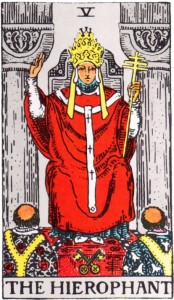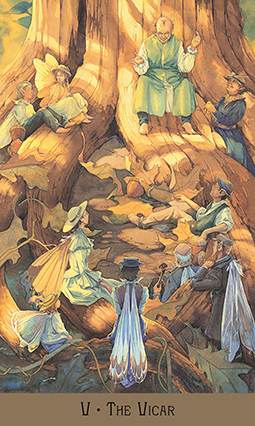Question Authority: The Hierophant and the Vicar
Readers, please enjoy this guest blog post by Lunaea Weatherstone, creator of a number of tarot decks, including the new Victorian Fairy Tarot.
The Hierophant is a card that doesn’t seem to get much love from the tarot community. We are a free-thinking bunch, generally speaking, and the Hierophant is often interpreted as being rigid, dogmatic, and spiritually constraining. The Rider-Waite-Smith card shows a throned Pope making a blessing gesture as two tonsured initiates kneel before him. The initiates are clearly in a less-powerful position, and traditionally this card can mean a surrender of spiritual free will to a higher authority.
 I’m actually rather fond of the Hierophant for a couple of reasons. First, I have always been drawn to the idea of spiritual vocation, so a card that pictures three people who have all chosen to offer themselves in devotional service to their deity is an appealing one. Second, I see this card as having the potential to represent what the Benedictine monk Brother David Steindl-Rast calls, “true and legitimate authority.” This is authority in the sense of “He is an authority on ancient Egyptian art.” It implies scholarly learning as well as real-world application of that learning. When you are in the presence of true authority, you don’t feel put down or constricted. True authority will always welcome questioning and discussion of ideas, for that is how we best learn and deepen in wisdom.
I’m actually rather fond of the Hierophant for a couple of reasons. First, I have always been drawn to the idea of spiritual vocation, so a card that pictures three people who have all chosen to offer themselves in devotional service to their deity is an appealing one. Second, I see this card as having the potential to represent what the Benedictine monk Brother David Steindl-Rast calls, “true and legitimate authority.” This is authority in the sense of “He is an authority on ancient Egyptian art.” It implies scholarly learning as well as real-world application of that learning. When you are in the presence of true authority, you don’t feel put down or constricted. True authority will always welcome questioning and discussion of ideas, for that is how we best learn and deepen in wisdom.
Brother David says: “The true and legitimate authority builds you up, augments your knowing, augments your ability to act rightly. It raises you up, increases your self-confidence, empowers you. Therefore, the great responsibility of everyone is to question authority. I am talking about a respectful, honest, straightforward questioning of authority. That is our duty, not just our privilege. That’s what keeps authority on the right track.” (From an interview in Tricycle magazine, Fall 1991)

When it came time to depict the Hierophant card for my Victorian Fairy Tarot (illustrated by Gary A. Lippincott), I wanted to show this idea of legitimate and—above all—approachable spiritual authority. My version shows a kindly fairy Vicar seated on the roots of an oak tree and speaking to members of his congregation. He shares his teachings with humility, respect, and love, which the grateful fairies return to him tenfold. The Vicar welcomes lively discussion and dialogue, and his gatherings often ring with the sound of merry laughter.
The word hierophant comes from the Greek hieros (sacred) and phainein (show). Without the need to control or condemn, the Vicar shows the sacred by example as well as by teaching. Nestled among the roots of the great tree of wisdom, the fairies can safely open their hearts as well as their minds.
Our thanks to Lunaea for her guest post! For more on the Victorian Fairy Tarot, browse the cards.








What a great take on this card (which never particularly speaks to me in the RW deck I use). I love your depiction.
It’s not about wheatear you like an image or not. The archetype represents an individual and a point of view that you will encounter in reality and will have to deal with.
Fairy and kittycat decks may be really really cute but are not of that much use to those who have graduated kindergarten.